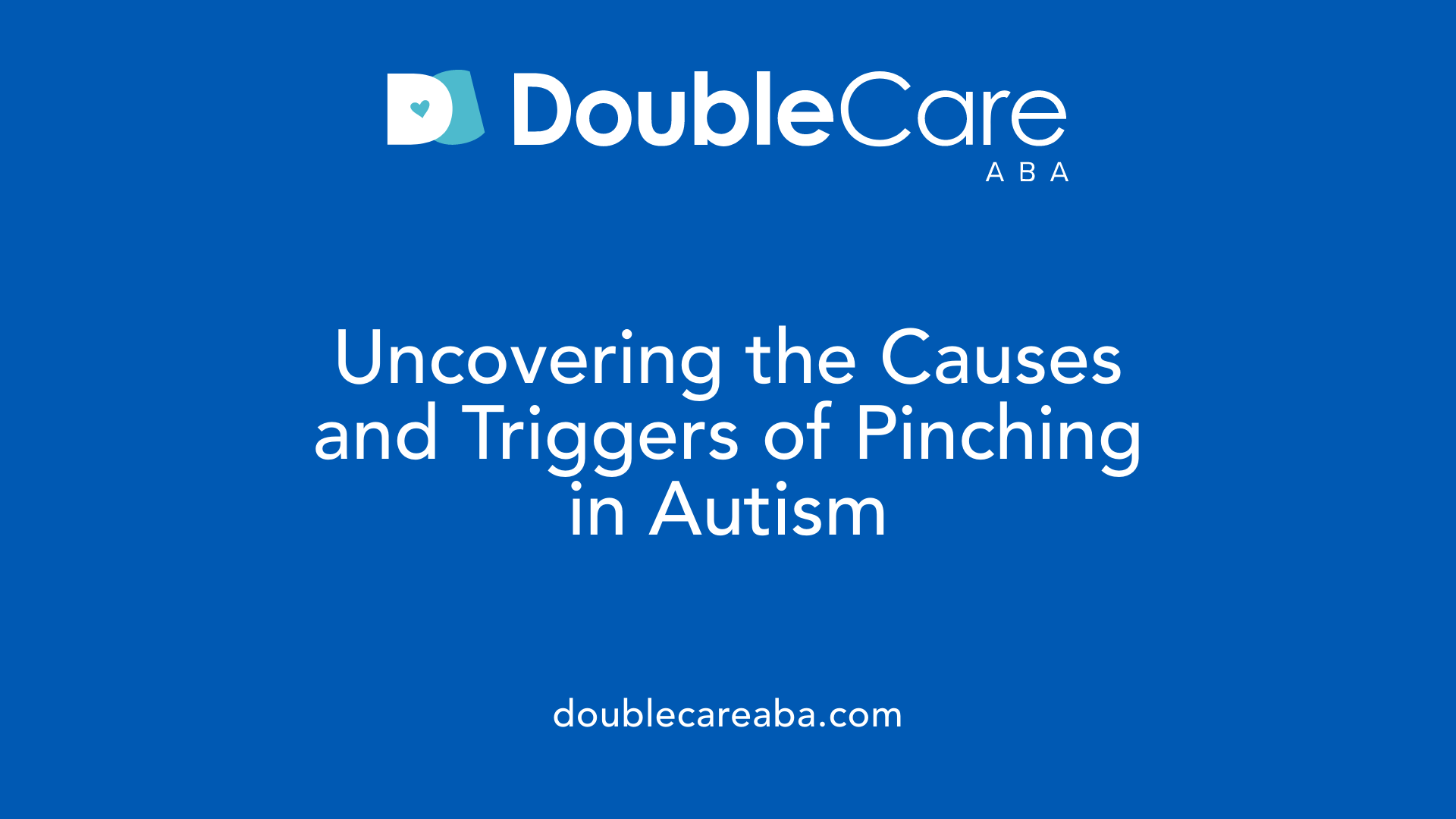An In-Depth Look at Autism Pinching Behavior
Pinching is a common behavior observed in children with autism spectrum disorder (ASD), often misunderstood or overlooked. While it may seem trivial or simply problematic, understanding the underlying causes, characteristics, and management strategies is crucial for caregivers and professionals. This article explores what autism pinching behavior entails, its triggers, how to identify its signs, and effective ways to address it compassionately and effectively.
Defining Autism Pinching Behavior and Its Characteristics

What is the behavior of pinching in children with autism, and what are its characteristics?
Pinching in children with autism is a common behavior that can serve multiple functions. It often appears as a repetitive movement, where a child might pinch themselves or others. This behavior can be playful but also might be self-stimulatory, used to regulate sensory input, or a response to emotional stress.
Children who pinch may do so intentionally or sometimes unintentionally, especially if exploring their surroundings or seeking comfort. The behavior can be directed toward themselves, such as pinching their arms or legs, or toward others, which may include caregivers, peers, or teachers.
The characteristics of pinching include repetitive motions that may seem impulsive or uncontrolled. It often occurs in clusters or episodes, especially during times of heightened emotion, sensory overload, or difficulty with communication.
Pinching is frequently a form of nonverbal communication. Children might use it to tell others they are upset, overwhelmed, or in need of attention without having the words to express their feelings.
This behavior can also include self-injurious acts where children pinch themselves with enough force to cause pain or injury, or might involve looking for sensory feedback by pinching to stimulate their nervous system.
Triggers for pinching include sensory overload, such as loud noises or bright lights, emotional upset like frustration or anxiety, change in routine, or environments that feel overstimulating or confusing.
Understanding the characteristics of pinching is essential for effective intervention. Recognizing that it often serves a purpose—whether sensory, emotional, or communicative—helps caregivers and professionals respond with empathy.
Behavioral strategies to address pinching focus on identifying the trigger and function of the behavior. Techniques include creating calming environments, teaching alternative ways to communicate needs, and providing sensory activities that fulfill the child's regulatory goals.
By observing patterns and context, caregivers can better understand when and why pinching occurs, allowing for more targeted and compassionate responses. This approach fosters trust and supports the child's overall emotional and sensory needs.
Causes and Triggers of Pinching in Children with Autism

What causes or triggers pinching behaviors in children with autism?
Pinching in children with autism is often misunderstood as simply a harmful act, but it usually stems from various underlying causes. Recognizing these triggers is essential for effective management and support.
One common cause is sensory overload or discomfort. Children with autism may have heightened sensitivities to sounds, smells, textures, or clothing. When these sensory inputs become overwhelming, children might pinch themselves or others as a way to seek relief or avoid certain sensations.
Emotional factors play a significant role as well. Feelings such as anxiety, frustration, or being overwhelmed can lead to pinching. Since many children with autism have difficulty expressing their needs verbally, pinching can serve as a nonverbal method of communication. It might also be a way to release built-up energy or manage emotional tension.
Environmental stresses are another key trigger. Changes in routine, loud noises, or unfamiliar settings can cause discomfort or confusion, prompting children to pinch as a response. A lack of preferred sensory input or overstimulation in busy environments can escalate this behavior.
Physical discomforts like pain or tiredness are also influential factors. When children are unwell, experiencing dental issues, or feeling exhausted, they might resort to pinching to express their discomfort.
Emotional distress from feeling unheard, stressed, or misunderstood can lead to self-soothing behaviors such as pinching. Children often seek ways to manage their feelings when they lack appropriate communication tools.
Additionally, attention-seeking is a common motivator. If a child notices that pinching results in adult attention, whether positive or negative, they might repeat the behavior to gain interaction.
Finally, pinching can serve as a self-regulation strategy for sensory or emotional experiences. When children cannot regulate these feelings effectively, they might use pinching as a calming or alerting mechanism.
Understanding these triggers through careful observation and keeping behavior diaries can help caregivers address underlying needs more effectively. Strategies like creating predictable routines, reducing overstimulating environments, and teaching alternative sensory or communication techniques can significantly decrease the occurrence of pinching behaviors.
Identifying the Signs of Pinching and Understanding Its Implications

What are the signs of pinching behavior, and what might they indicate about a child's needs or state?
Children with autism may often exhibit behaviors such as pinching, which can serve various functions related to their emotional and sensory needs. Signs of pinching include repeated squeezing or pinching of their own skin or the skin of others. This behavior might be subtle or quite pronounced, and it is often observed alongside other indicators of distress.
Typically, pinching is accompanied by signs that the child is experiencing some form of discomfort or seeking sensory input. For example, a child might pinch themselves repeatedly, indicating a need for sensory stimulation or an attempt to self-soothe. Alternatively, pinching others could be a way to communicate frustration or a response to overstimulation.
These behaviors may also manifest as stereotypic or repetitive movements aimed at self-stimulation, managing anxiety, or trying to communicate feelings when verbal skills are limited. Children might also pinch as a way of seeking sensory input, especially when they are feeling overwhelmed or under-stimulated.
Recognizing these warning signs is essential because they often point to underlying needs. For instance, a child pinching due to sensory overload may be experiencing too much noise, light, or visual stimuli. Similarly, pinching linked to frustration may indicate difficulties in expressing needs verbally.
Some children pinch to regain a sense of control in overwhelming situations. This behavior can be a response to feelings of anxiety or inability to communicate adequately. The behavior may also serve as a calming action or a form of self-regulation.
Understanding these signs helps caregivers and professionals identify when a child is overwhelmed, stressed, or seeking sensory input. This insight allows for implementing tailored support strategies, such as providing sensory breaks, using visual cues, or teaching alternative communication methods.
How can recognizing these behaviors improve support and intervention?
By noticing when and why a child pinches, caregivers can intervene with appropriate strategies to reduce distress and promote positive behaviors. These strategies include creating a calm environment, offering sensory activities suited to the child's needs, and teaching communication skills.
In summary, pinch behaviors are complex and often a reflection of a child's internal state. Recognizing the signs and understanding their implications is crucial for supporting children with autism in developing healthier ways to express their needs and manage their emotions.
Strategies for Managing and Intervening in Pinching Behavior

How can parents and caregivers manage and intervene when a child with autism exhibits pinching behavior?
Managing pinching in children with autism requires a thoughtful approach centered on understanding the behavior’s underlying reasons. First, observation is crucial. Keep a behaviour diary to note the circumstances leading up to the pinching, what happens afterward, and any patterns that emerge. This helps identify triggers like sensory needs, frustration, or environmental stressors.
Once triggers are identified, environmental modifications can be very effective. For example, providing sensory tools such as stress balls, fidget toys, or engaging in sensory activities like swinging or tactile play can help fulfill sensory needs. Creating a calm, predictable environment reduces overstimulation and helps prevent episodes.
During a pinching episode, caregivers should respond calmly. Limiting eye contact can reduce escalation, and they should use a gentle, firm voice to say "no pinching." If necessary, removing the child from the situation swiftly and safely can prevent further harm. It’s important to avoid overreacting, yelling, or punitive responses, as these can increase stress or reinforce the behavior.
Positive reinforcement plays a vital role. When the child uses appropriate ways to communicate or self-regulate, praise and reward these behaviors. Teaching alternative communication strategies, such as signing, picture exchange communication, or using a communication device, helps the child express needs without resorting to harmful actions.
Developing a structured routine and using visual aids like social stories can prepare children for transitions and reduce anxiety, making challenging situations more manageable.
Collaboration with professionals such as speech therapists, occupational therapists, and behavioral analysts can help create individualized intervention plans. These plans may include specific behavioral strategies, environmental adjustments, and communication development.
Consistent monitoring, including keeping detailed records of behaviors and their triggers, supports ongoing adjustments to intervention strategies. Over time, these proactive and reactive measures work together to lessen the frequency of pinching and encourage healthier ways for children to communicate and seek sensory input.
Understanding Why Self-Injury Like Pinching Serves a Purpose

Why do children with autism engage in self-injurious behaviors like pinching, and what purpose might it serve?
Children with autism often resort to self-injurious actions such as pinching as a way to communicate or manage their internal states. These behaviors serve multiple functions, especially when verbal communication skills are limited.
Many children use self-injury to express needs or discomfort they cannot articulate through words. For example, pinching might be a way to signal pain, frustration, or a desire for attention. It acts as an effective form of non-verbal communication, helping children indicate when they need help or are overwhelmed.
Aside from communication, self-injury plays a significant role in sensory regulation. Children might pinch themselves to either seek sensory input—providing a tingling or pain sensation that helps them feel more grounded—or to decrease overstimulation by creating a sensory
Differentiating Pinching from Other Autism-Related Behaviors

How can we differentiate pinching from other autism-related behaviors such as stimming or biting?
Understanding the differences between behaviors like pinching, stimming, and biting is crucial for effective management and support of children with autism.
Pinching involves applying pressure or squeezing with fingers or hands, often intentionally and with enough force to cause localized pain or even injury. This behavior may be driven by sensory needs, discomfort, frustration, or a way to communicate feelings of distress that the child cannot verbalize.
Stimming, on the other hand, includes repetitive movements or sounds such as hand-flapping, rocking, or humming. These are usually self-calming behaviors that help the child manage sensory overload or emotional tension. Unlike pinching, stimming generally does not aim to cause discomfort or harm; instead, it serves as a means of self-regulation or enjoyment.
Biting can serve dual purposes: it may be a response to stress or a way to seek sensory input. It can be directed at oneself or others and often occurs during times of anxiety, fatigue, or sensory overload. Biting might also be a way to express feelings when communication is limited or to seek sensory stimulation.
To distinguish these behaviors, it is essential to observe the intent, control, and context. Pinching is usually deliberate and can cause harm, indicating a possible need for intervention to address underlying causes like emotional regulation or sensory needs.
In contrast, stimming behaviors tend to be self-soothing rather than harmful, and their purpose is primarily self-regulation. Biting often occurs in response to specific triggers like stress or sensory deprivation, and it may serve as an attempt to communicate or seek sensory input.
Identifying whether the behavior causes injury or serves a self-regulatory purpose helps caregivers and professionals develop appropriate strategies, which include teaching alternative communication methods, providing sensory activities, and addressing emotional needs.
Understanding these differences aids in creating tailored behavioral plans that support the child's development and well-being.
| Behavior Type | Typical Characteristics | Purpose | Harm Potential | Common Triggers |
|---|---|---|---|---|
| Pinching | Applying pressure or squeezing, can cause pain or injury | Communication, sensory seeking, emotional regulation | Yes | Frustration, overstimulation, routine changes |
| Stimming | Repetitive movements or sounds, such as hand-flapping or humming | Self-calming, managing sensory overload | Usually no | Excitement, anxiety, fatigue |
| Biting | Biting self or others, mouthing objects | Stress relief, sensory input, communication | Possible, especially if aggressive | Stress, frustration, sensory overload |
Recognizing the specific characteristics and purposes of these behaviors allows for more effective intervention and reduces the risk of misunderstanding or mislabeling actions.
Educational Resources for Addressing Pinching in Autism

What are some educational resources available to help parents and caregivers address pinching behaviors?
Parents and caregivers seeking to manage pinching and other harmful behaviors in children with autism have access to a wide range of educational tools and support services. These resources are designed to enhance understanding, promote positive behavior, and provide effective intervention strategies.
One valuable resource includes behavior management guides issued by autism support organizations. These guides offer practical advice on identifying triggers, understanding the function of behaviors, and implementing appropriate responses. Many organizations also develop educational programs and videos that demonstrate techniques for calming and self-regulation. For example, tools like "Tucker the Turtle" emphasize teaching children coping skills and emotional regulation through engaging storytelling.
Developmental screening tools are essential for early detection of social-emotional challenges. Resources such as "Learn the Signs Act Early" help caregivers monitor developmental milestones and flag early signs of behavioral concerns, allowing for timely intervention.
Support services including mental health consultation and parent training centers provide personalized guidance tailored to each child's needs. These programs often include workshops, one-on-one coaching, and group support to empower caregivers with effective strategies.
Organizations like Zero to Three focus specifically on early childhood development. They produce educational materials that cover positive discipline, ways to handle challenging behaviors, and strategies for supporting emotional growth.
Furthermore, many resources focus on educating about sensory needs and sensory-based interventions. Examples include materials on using visual aids and social stories to help children understand and anticipate changes, reducing anxiety and outbursts.
In summary, a combination of developmental screening, behavioral guides, caregiver training, and supportive community programs equips parents and caregivers with the knowledge necessary to address pinching and promote healthier behaviors in children with autism.
Support organizations and programs
| Organization | Focus Areas | Resources Provided | Additional Details |
|---|---|---|---|
| Autism Speaks | Advocacy, Education | Toolkits, Webinars, Support Groups | Offers educational resources for behavior management |
| Zero to Three | Early Childhood Development | Parenting Guides, Training Modules | Emphasizes emotional and social development |
| National Autism Association | Safety, Behavior Management | Resources on self-injury, safety tips | Focus on preventing and managing self-injurious behaviors |
Visual aids and developmental screening tools
| Tool/Resource | Purpose | Method | Effective Use |
|---|---|---|---|
| Visual schedules | Reduce anxiety, clarify routines | Picture cards, charts | Prepare child before activities |
| Social stories | Explain social situations | Short narratives with images | Help children understand triggers and responses |
| Learn the Signs Act Early | Monitor developmental milestones | Checklists, apps | Early identification of concerns |
Parent training and professional guidance
| Service | Focus | Delivery | Benefits |
|---|---|---|---|
| Parent training centers | Behavior management, communication | Workshops, coaching sessions | Equip parents with practical skills |
| Mental health professionals | Emotional regulation, behavioral therapy | In-office or telehealth sessions | Personalized support and intervention |
Materials on positive discipline and coping strategies
| Material Type | Content | Usage Tips | Example |
|---|---|---|---|
| Booklets and pamphlets | Positive discipline methods | Review regularly, reinforce at home | Using praise to reinforce calm behavior |
| Video lessons | Coping techniques, calming exercises | Watch together, practice actively | Deep breathing exercises |
| Online webinars | Managing challenging behaviors | Engage in Q&A, follow-up | Strategies for dealing with pinching |
In conclusion, a broad spectrum of educational resources—ranging from organizational programs to visual aids and parent training—are available to support families in managing behaviors like pinching. These resources enable caregivers to understand underlying causes, implement effective strategies, and promote emotional well-being in children with autism.
Behavioral Assessment and Prevention Techniques

What behavioral assessment and prevention techniques are effective in managing pinching behaviors in children with autism?
Managing pinching in children with autism requires a thoughtful and systematic approach. The first step involves conducting detailed behavioral assessments to understand the roots of the behavior. One of the most effective tools is the functional behavioral assessment (FBA), which often includes gathering ABC data — recording the Antecedents (what happens before the behavior), the Behavior itself, and the Consequences (what happens afterwards). These insights help identify specific triggers such as sensory overload, frustration, or communication difficulties.
Based on the assessment, professionals create individualized intervention plans tailored to each child's needs. Teaching alternative communication methods is an essential part of this process. For example, children might learn to use picture exchange communication systems (PECS) or sign language to express their needs and reduce behaviors driven by frustration.
Environmental modifications also play a role in prevention. Adjusting the child's environment — like seating arrangements, reducing visual or auditory distractions, or providing sensory tools such as fidget toys or calming visual aids — can lessen triggers. Regular sensory breaks and access to preferred sensory activities can fulfill sensory needs in a positive way, decreasing the likelihood of pinching as a form of self-regulation.
Reinforcement strategies are crucial. Positive reinforcement involves praising and rewarding appropriate behaviors, such as using words or gestures instead of pinching. This encourages the child to adopt better coping mechanisms.
Proactive management also includes strategies like redirection, where the caregiver gently guides the child's attention away from unwanted behaviors towards more acceptable activities. Additionally, teaching self-regulation skills, such as breathing exercises or calming routines, empowers children to manage their arousal levels.
Effective management of pinching behaviors often involves collaboration with a multidisciplinary team. This team may include speech therapists, occupational therapists, behavior analysts, and educators. Together, they develop and implement individualized behavior support plans that are regularly reviewed and adapted.
In summary, an integrated approach involving careful assessment, tailored interventions, environmental adjustments, positive reinforcement, and professional support creates a supportive setting that minimizes triggers and fosters healthier behaviors.
Underlying Reasons for Self-Injurious Behavior in Autism

What are the underlying reasons for self-injurious behaviors like pinching in individuals with autism?
Self-injurious behaviors (SIB) such as pinching, head-banging, or skin-picking are complex actions often driven by a mixture of neurological, sensory, emotional, and behavioral factors. These actions are not simply acts of naughtiness but are expressions of underlying distress or attempts to communicate needs.
Neurochemical and neurological factors play a significant role in understanding SIB. Research using neuroimaging techniques indicates differences in brain structure and function in individuals with autism who engage in self-injury. Variations in neurotransmitter systems—such as serotonin, dopamine, GABA, glutamate, and the body's opioid system—may alter pain perception and stress responses. Some individuals may experience pain differently, which can lead to behaviors like pinching or biting as a way to feel something when sensory input is hypo-responsive or to alleviate discomfort due to hyper-responsiveness.
Sensory processing differences are a hallmark of autism. Many children are either hypo- or hyper-sensitive to sensory stimuli. Those with hypo-responsiveness may seek additional sensory input through self-injury, while hyper-sensitive children might use SIB to block or cope with overwhelming stimuli. For example, pinching could serve as an attempt to regulate sensory overload or deprivation.
Communication difficulties frequently lead to self-injury. When children struggle to express their needs, desires, or discomfort verbally, they may rely on behaviors like pinching or scratching as alternative forms of communication. This act can be a plea for help, to indicate pain, or to seek attention.
Psychological factors such as emotional distress and trauma also contribute substantially. Feelings of anxiety, fear, frustration, or anger, especially when an individual cannot communicate these feelings effectively, often manifest through SIB. Memories of past trauma or ongoing stressors, like bullying or environmental changes, can intensify these behaviors.
Furthermore, behavioral reinforcement plays a role. Sometimes, caregivers inadvertently reinforce self-injury by responding in ways that temporarily stop the behavior, such as giving a favorite toy or removing the child from an overstimulating environment. This can unintentionally strengthen the SIB as a learned method to achieve a desired outcome.
Understanding these diverse underlying causes requires a comprehensive approach—combining behavioral assessments, medical evaluations, and psychological insights. Keeping detailed journals or conducting functional behavioral assessments (FBA) help unravel specific triggers and motivations, paving the way for tailored interventions.
Effective strategies include teaching alternative communication methods, gradual desensitization to sensory stimuli, reinforcing positive behaviors, and addressing underlying emotional or medical issues. Interventions might encompass behavioral therapy, sensory integration therapy, or medical treatments when neurochemical imbalances are involved.
In conclusion, SIB in autism arises from a mixture of neurological, sensory, communicative, and emotional factors. Recognizing and addressing these root causes is critical for supporting individuals in expressing themselves appropriately and reducing harmful behaviors.
Supporting Children with Autism in Managing Pinching Behaviors
Understanding autism pinching behavior requires a comprehensive approach that recognizes the multifaceted causes, from sensory needs and emotional stress to communication challenges. Effective intervention involves not only behavioral strategies—such as environmental modification, positive reinforcement, and teaching alternative communication methods—but also compassion and patience. Working collaboratively with professionals and educators, caregivers can implement tailored plans that address individual triggers and promote emotional regulation. By fostering supportive environments and providing appropriate sensory and communication tools, caregivers can help children with autism develop safer ways to express themselves and regulate their emotions, ultimately improving their overall well-being and quality of life.
References
- How to stop my autistic child from pinching me - Kindship
- Causes and Interventions for Self-Injury in Autism
- How to Resolve Biting in Children with Autism - Dr. Mary Barbera
- Self-injurious behaviour - a guide for all audiences
- Help our child who has autism he won't stop pinching or hitting!
- Hand Flapping and Stimming in Autism
- Autism Pinching Behavior Causes - Astra ABA
- Self-injurious behaviour - a guide for all audiences
- Aggressive Behaviors or Intense Energy? - Autism Treatment Center
- Calming the Agitated Patient: Providing Strategies to Support ...














